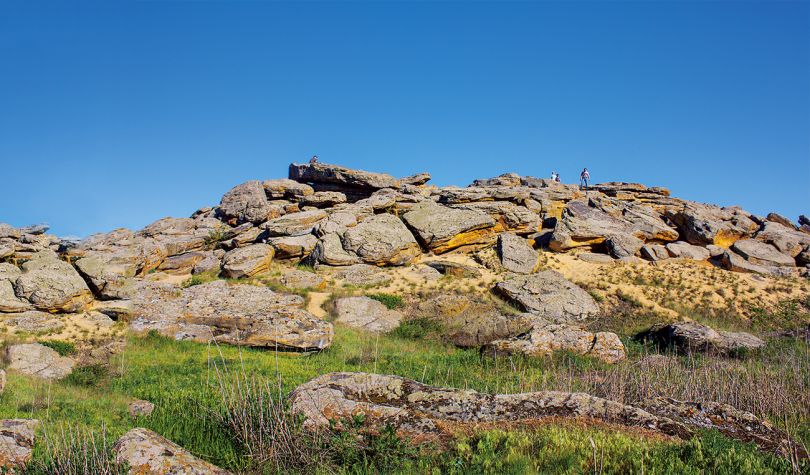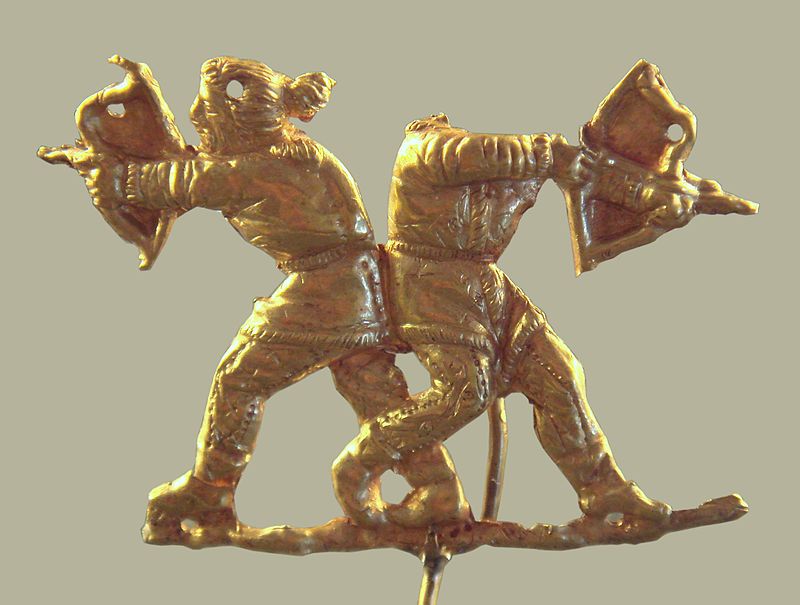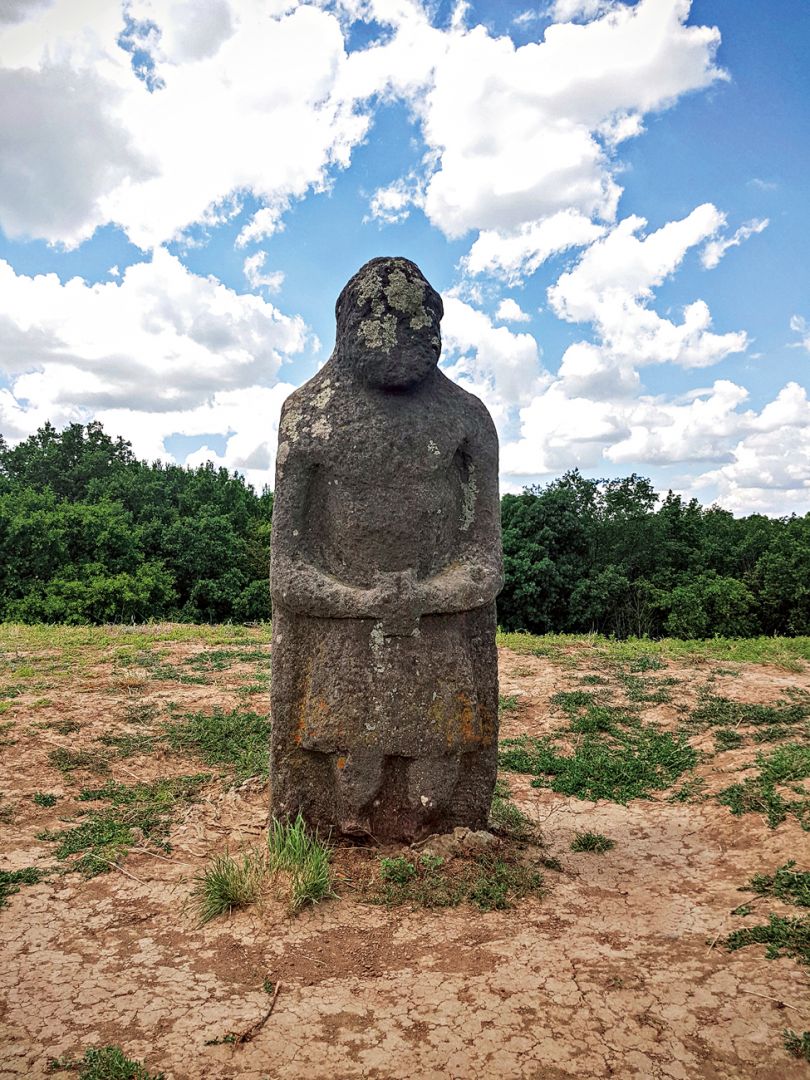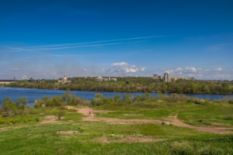Аrchaeologists say the first settlements in Ukraine’s southeastern steppes cropped up in the Middle Paleolithic, i.e. over a hundred thousand years ago. The steppe eventually became a vital source of the country’s aspirations for freedom and statehood.
Kamyana Mohyla
 Arguably one of the most ancient shrines in history, Kamyana Mohyla (Stone Grave) can be found near Melitopol, on the bank of the Molochna River. This unique natural monument emerged about 12 million years ago, well ahead of the first humans with their Stonehenge and Egyptian pyramids.
Arguably one of the most ancient shrines in history, Kamyana Mohyla (Stone Grave) can be found near Melitopol, on the bank of the Molochna River. This unique natural monument emerged about 12 million years ago, well ahead of the first humans with their Stonehenge and Egyptian pyramids.
The site is believed to have once been surrounded by the fabled Sarmat Sea. The sea then retreated, leaving behind a steep hill riddled with caves. By the end of the Stone Age, the first Homo sapiens settled at the foot of the sandy mountain covered with stone slabs. The ancient hunters-gatherers started the rock art fad by painting petroglyphs on the walls of their caves. It is possible that these artists used Kamyana Mohyla not just as a shelter but also as a ritual site. The tradition continued well into the Bronze Age. Several hundred wall paintings are to be seen on location at present. Researcher study them to better understand how prehistoric people perceived the world around them. One thing is already known: the central focus of our ancestors’ beliefs was the Tree of Life, the symbol of fertility and eternity repeatedly mentioned in the Kamyana Mohyla cave art.
Kamyana Mohyla is protected as a national historical and archaeological site. Tourists are welcome to visit throughout the week.
Scythian gold
 The Scythians, who controlled the Ukrainian steppes in the 7th to 4th centuries BC, left behind numerous burial places of their leaders. Deceased rulers would be interred along with their kin, servants, horses, chariots, weapons, cutlery and jewellery. The largest and most famous such mounds are situated in Dnipro Region (Chortomlyk, Tovsta Mohyla and the Olexandropil Mound), as well as in Zaporizhia Region (Solokha and Haymanova Mohyla).
The Scythians, who controlled the Ukrainian steppes in the 7th to 4th centuries BC, left behind numerous burial places of their leaders. Deceased rulers would be interred along with their kin, servants, horses, chariots, weapons, cutlery and jewellery. The largest and most famous such mounds are situated in Dnipro Region (Chortomlyk, Tovsta Mohyla and the Olexandropil Mound), as well as in Zaporizhia Region (Solokha and Haymanova Mohyla).
All the Scythian treasures were transported to the Hermitage museum in Russia’s St Petersburg in the 19th century. These included the Chortomlyk silver amphora depicting a scene of Scythians taming their horses. The vessel was originally found 22 km away from the town of Nikopol.
The most precious piece of Scythian jewellery, a golden pectoral, was uncovered by the Ukrainian archaeologist Borys Mozolevsky in 1971. Found in the Tovsta Mohyla tomb of an unknown Scythian nobleman, near the town of Pokrov in Dnipro Region, this female breastpiece weighs in at 1.2 kg and is ranked among the most valuable archaeological finds of the 20th century. The pectoral is on display, alongside other Scythian masterpieces, at the Museum of Historical Treasures of Ukraine in Kyiv.
It was in the Scythian times that the first signs of statehood emerged in Ukraine. One reminder of this are the vestiges of the Kamianka settlement, all that remains of the erstwhile Scythian capital city which thrived under Atheas the king in the fourth century BC. Most of this ancient site was unfortunately consumer by water during the launch of the Kakhovka Reservoir in Zaporizhia Region.
The Sarmatian spirit
 The Scythians were driven from the steppes by the belligerent Sarmatian tribe in the third century BC. This did not change the archaeological landscape much: the Sarmatians also interred nobles in burial mounds, complete with weapons and treasures; they also favoured animal-themed golden adornments and spoke a “distorted” variation on the Scythian language. Herodotus held that the Sarmatians were a cross-breed of Scythians and Amazons.
The Scythians were driven from the steppes by the belligerent Sarmatian tribe in the third century BC. This did not change the archaeological landscape much: the Sarmatians also interred nobles in burial mounds, complete with weapons and treasures; they also favoured animal-themed golden adornments and spoke a “distorted” variation on the Scythian language. Herodotus held that the Sarmatians were a cross-breed of Scythians and Amazons.
This theory is indirectly supported by the high societal status of the Sarmatian women, who would wear men’s garments, carry weapons and ride horseback. The Sarmatian nomads did not get to found a single settlement in Ukraine. The people’s only heritage, apart from the burial sites, comes in the form of fables about their light cavalry, the backbone of the Sarmatian army, and of their quarrelsome nature. The Sarmatians’ descendants lived on as the Polish gentry and the Zaporozhian Cossacks. Bohdan Khmelnytsky’s son Yurii held the title of Prince of Sarmatia.
The Cossack settlements
 In the Middle Ages, the Ukrainian steppe became part of the so-called Wild Fields, a virtually lawless territory. It was on the border of this area, past the Dnieper River rapids, that Cossacks started settling at the end of the 15th century. The fortresses they built were called zasikas in Ukrainian, sharing the same origin with the later term sich denoting Cossack settlements.
In the Middle Ages, the Ukrainian steppe became part of the so-called Wild Fields, a virtually lawless territory. It was on the border of this area, past the Dnieper River rapids, that Cossacks started settling at the end of the 15th century. The fortresses they built were called zasikas in Ukrainian, sharing the same origin with the later term sich denoting Cossack settlements.
The first sich was built on the island of Mala Khortytsia (now known as Baida Island) by the magnate and Cossack leader Dmytro Baida (Vyshnevetsky) in 1553. However, four years later the fortress was destroyed by the Tatars. There were a total of eight sich periods in the history of the Zaporozhian Cossacks.
That period can now be studied at the Zaporozhian Cossacks History Museum on Khortytsia island. The island itself was never the site of a single Cossack sich, but it has, on display, all the key components of such a fortification. The museum also keeps the artifacts of the Vyshnevetsky fortress. Its collection contains more than 32,000 exhibits.
History at your fingertips
 ...While you are on Khortytsia, check out the Scythian Stan burial site set up at 57 metres above sea level, making it the island’s highest point. The genuine Scythian burial mounds come complete with Ukraine’s largest collection of Sumerian, Scythian and Cuman kurgan stelae, brought to the site from the steppes neighbouring the Sea of Azov. This is where you get a chance to literally touch the country’s millennia of history.
...While you are on Khortytsia, check out the Scythian Stan burial site set up at 57 metres above sea level, making it the island’s highest point. The genuine Scythian burial mounds come complete with Ukraine’s largest collection of Sumerian, Scythian and Cuman kurgan stelae, brought to the site from the steppes neighbouring the Sea of Azov. This is where you get a chance to literally touch the country’s millennia of history.
Author: Liudmyla Semyvolos
Photo: shutterstock, uk.wikipedia.org








